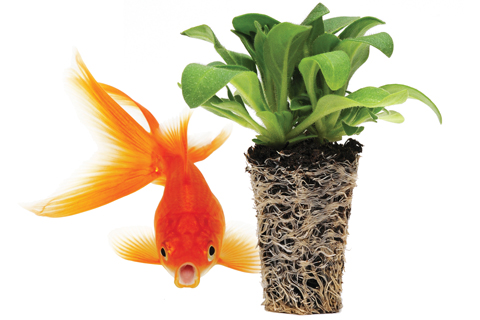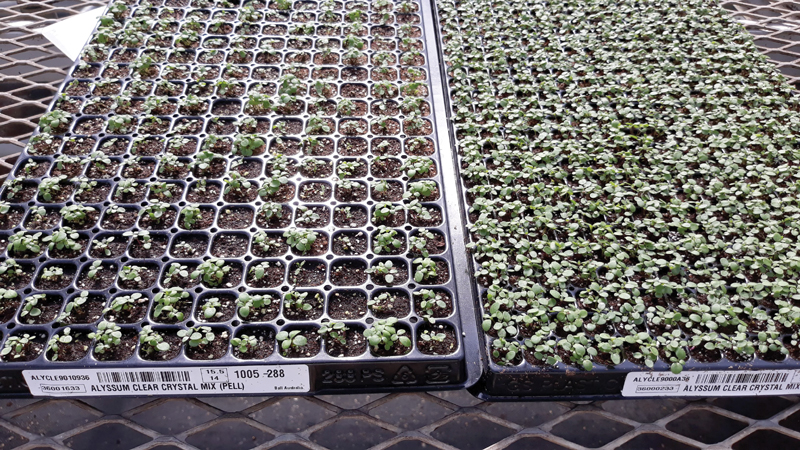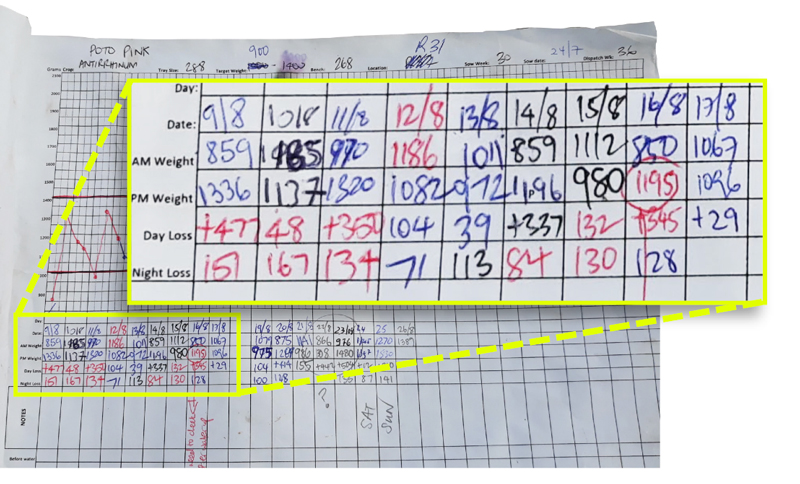11/1/2019
Duh! It’s All About the Water
Jennifer Zurko
Ball Seed’s Senior Technical & Research Specialist doesn’t have a problem telling you when you’re doing something dumb in the greenhouse. In fact, almost every grower I know has the utmost respect for Dr. Will Healy. He may point out the dozens of mistakes you’re making, but you take your licks because he’s usually right. (I mean, one of his presentations is titled, “Stupid Stuff to Stop Doing”—he serves his words whole, never minced.)
Dr. Healy’s plethora of knowledge could fill more plug trays than we’d ever see in our lifetimes, which is why at every Plug & Cutting Conference, every session at Cultivate where Will is presenting, the room is packed to where people have to stand.
Since the late 1990s, Will has conducted research on water management, and through the years, he said he’s learned more and more from the growers he visits. (And it’s a lot—Will is always on the road.) From extensive research experiments, trial-and-error and anecdotal evidence, Will and a few other colleagues have developed a system to help you truly calculate how much water your plants are using and losing at any given time. Called “Water By Weight,” you’ll know, by practically the exact gram, when you need to water (or not), when to apply PGRs (or not) and if you’re going to have insect/disease problems (or when).
Healy-isms
Will begins his talks on water management with this: “Incorrect watering kills more seedlings and plants than anything else we do.”
 He says that when he or his counterpart Dr. Todd Cavins walk into a greenhouse to investigate a problem, 70% of the time it’s because of “incorrect watering”—disease problems and root rot are usually because of too much water; roots that don’t go down far enough or plants that are too “hard” are usually because of too little water at the right time.
He says that when he or his counterpart Dr. Todd Cavins walk into a greenhouse to investigate a problem, 70% of the time it’s because of “incorrect watering”—disease problems and root rot are usually because of too much water; roots that don’t go down far enough or plants that are too “hard” are usually because of too little water at the right time.
“If you break it down to a very simplistic way: What are we trying to do? We’re trying to manage how much water is being taken up by the roots. And you want it to be consistent,” he said.
One of Will’s famous sayings is: “Fish grow in water, roots grow in air.” Meaning roots need air in the soil to develop a well-branched root system with a lot of hair roots. In reality, we sell roots, because without a good root zone and structure, the plant over the soil line isn’t going perform. And nine out of 10 times, when the roots are having a problem, it’s because of incorrect watering.
So the source of most greenhouse problems begins and ends with poor water management, whether you’re growing an 18-in. poinsettia plant or a quarter-inch plug.

Weighing your water
Will says “incorrect watering” is a useless term—what does that even mean? That’s why he’s been working to remove the ambiguity out of water management for the last 10 years.
“What we found is that the phrase ‘too wet’ is not actionable. When we use ambiguous terms, we frustrate people,” he said.
Pictured: The nice thing about Water by Weight is that you can incrementally change how much you water. As you can see here, even 100 grams of water makes a difference.
A few years ago, Will aggressively promoted the five stages of moisture—1 being too dry, 5 being saturated. But it was always a qualitative way to measure how much/how little the plants were getting. Growers needed more.
“Everybody is challenged with: Should I water or shouldn’t I water? We’ve really never come up with a clear, reproduceable way to predict, ‘If I water today, what’s it gonna look like tomorrow?’” explained Will. “Probably about six, seven years ago that became the very clear stumbling block in the training. I could teach someone, ‘You walk this speed. You use this nozzle. You use this boom.’ I could tell you how to put out the water. I could tell you when you have too much water on the plants. But you’re standing there, looking at this pot and you’re trying to make a decision on whether you should water today.”
So Will had to take the fundamental science of how you water when you water and translate that into an “actionable activity” that a grower or greenhouse worker could understand. The actionable activity of “too wet” is the time from when your wet target to your dry target is too long. But how do you calculate that? You weigh the plug tray and measure the change in weight, which is the loss of water weight.
 First, you figure out how much water you lose in a 24-hour period. A study conducted in Japan found that most water is lost during what Will calls the “night period,” which begins after the last watering of the day until the first watering the next morning. If the last watering was at 3:00 p.m. and the next one isn’t until 7:00 a.m. the next day, that’s 16 hours—a long time to be losing water.
First, you figure out how much water you lose in a 24-hour period. A study conducted in Japan found that most water is lost during what Will calls the “night period,” which begins after the last watering of the day until the first watering the next morning. If the last watering was at 3:00 p.m. and the next one isn’t until 7:00 a.m. the next day, that’s 16 hours—a long time to be losing water.
Pictured: Part of the Water by Weight system is knowing how much water you lose within a 24-hour period and figuring out what your target is from wet to dry.
If you water your plants and weigh them after the last irrigation before you leave for the day and then weigh them when you come in the next morning, you’ll know how much weight you lost during that time.
“There are some boundaries of what you need to lose to be successful, which is part of what we’ve learned over the years,” said Will. “A healthy, overnight weight loss is between 150 and 200 grams overnight. If you lose an equal amount during the day, it’s easy to calculate your 24-hour water weight loss.” Once you know your daily weight loss, you can start to anticipate if you should water today or tomorrow. You want to go from your wet target to your dry target every two to three days to promote good root growth.
“The nice thing about Water By Weight is when you start looking at it by specific weights, when things aren’t going well, you can then incrementally change,” said Will. “Because if a tray comes off the sowing line at 800 grams and the pellets aren’t breaking down, we can say, ‘Let’s add another 100 grams of water to 900 grams.’ If the pellet breakdown is still not right, we take it up to 1,000 grams—and germination is even better. And if you take it up to 1,100 and germination declines, you now know the optimum amount of water to add to optimize germination. It’s a way you could very easily dial in to the best weight. And every operation is going to have their own best target number.”
The decision on when to water is not one to be taken lightly because so many things are tied into it; no one wants a domino effect of problems.
“If you want to add fertilizer or growth regulators or a fungicide drench tomorrow, the question is, how do you make that decision? Because if I understand how much water I’m going to lose in a unit of time—during the day, overnight, next week—then I can make a much more informed, predictive decision on when to water,” said Will.
And with the Water By Weight system, you can still use the five stages of moisture, especially if you’re growing plugs or rooting cuttings. Water By Weight allows you to turn your process from qualitative to quantitative, said Will.
He gave an example: “For a 102 tray size versus a 512, you know your target weights are different. So Level 4 in a 102 tray is going to be heavier than a 512. You always want to go from a 4 to a 2. You do have to adjust it as the plants get bigger and heavier, and you do have to increment the weights. Every operation has to set their own targets and that’s the beauty of this. It now gives you a very actionable, directive thing that you can do.”
Another benefit of weighing your plants is that it makes it easier to train someone. Telling someone, “Water these plants until they’re wet—but not too wet” will confuse and frustrate them, setting them up for failure. If you show them where the plants should fall within the limit you’ve set for that crop in your greenhouse based on an actionable measurement of weight, that’s A LOT easier for people to grasp.
“The first step in training a person to use Water by Weight is getting them to realize that they’re changing the weight,” said Will. “They control it. You’re trying to create a personal connection between the waterer and the water weight. That is a very abstract concept to the person you hired.
The job isn’t ‘to water’—the job is to dry the plants out so you can water. We need to change the paradigm of how we’re instructing people because we’re doing it backwards.”
All it takes to start implementing the Water By Weight system are scales (Will said you can find some online for $20), paper, pen and a clipboard. Once you establish your target weight, you can make the decision on when to water with more confidence. And you’ll be able to better manage—and even avoid—disease, insect, nutrition and growth regulation problems.
“A grower is constantly just fixing stuff,” said Will. “When you start looking at all of the treatments that you’re applying—especially if you’re putting on a lot of growth regulators or fungicides—focus on what is driving the final results in your watering process. Once you control your water practices, the things that you’re doing today to fix the problems will go away.” GT